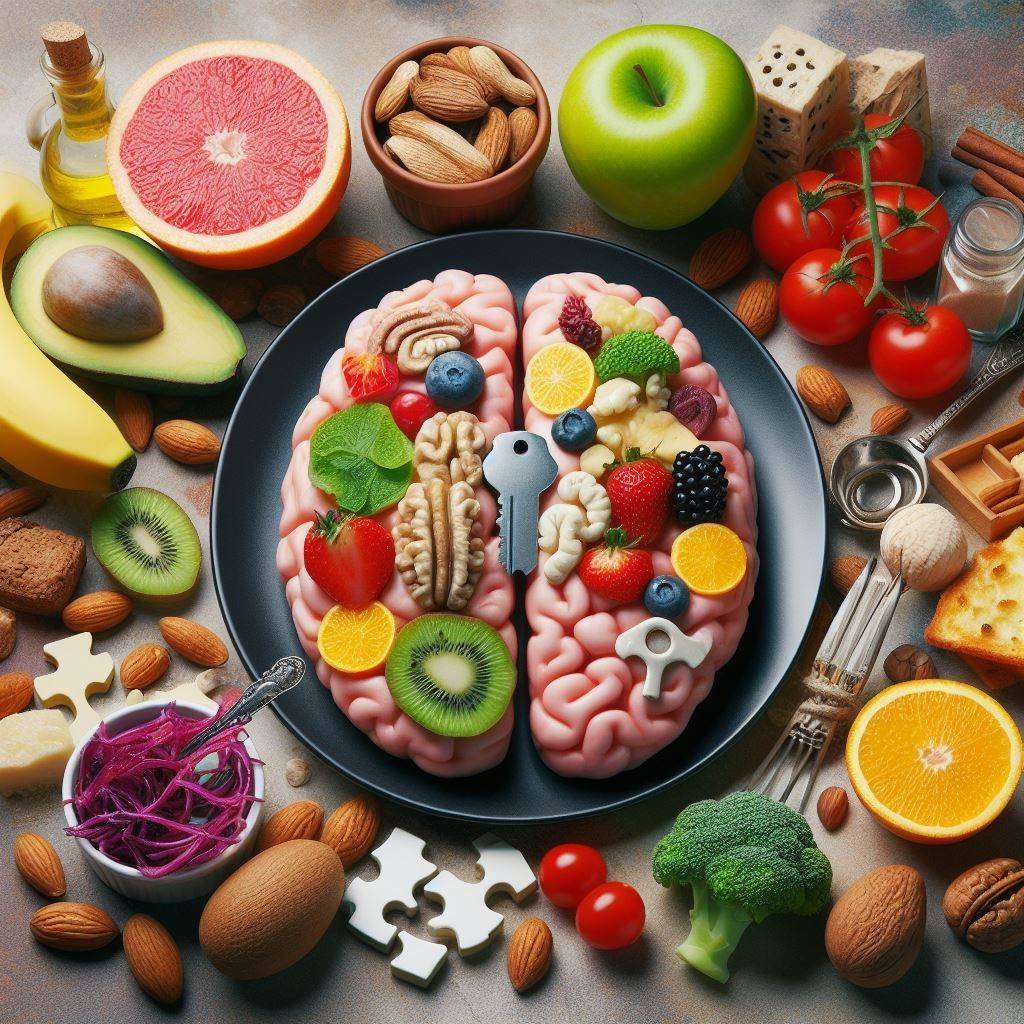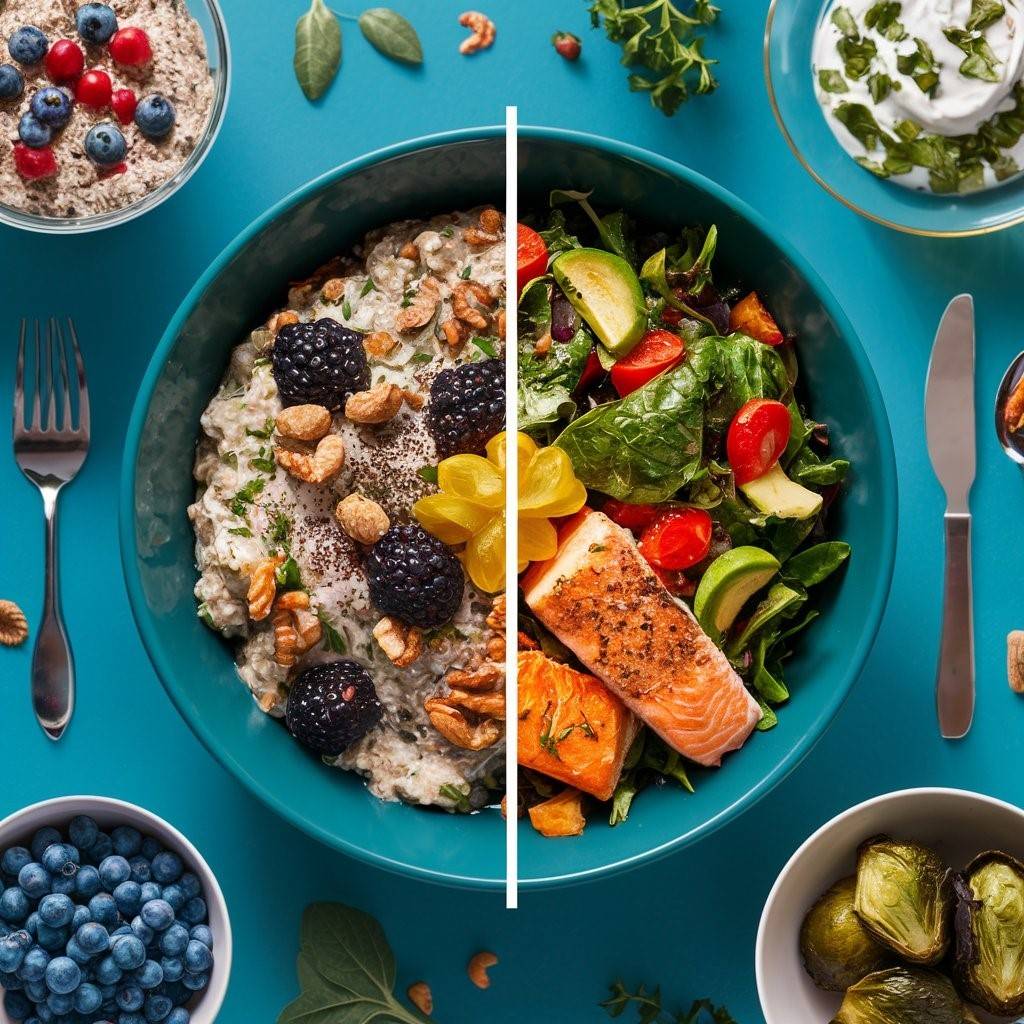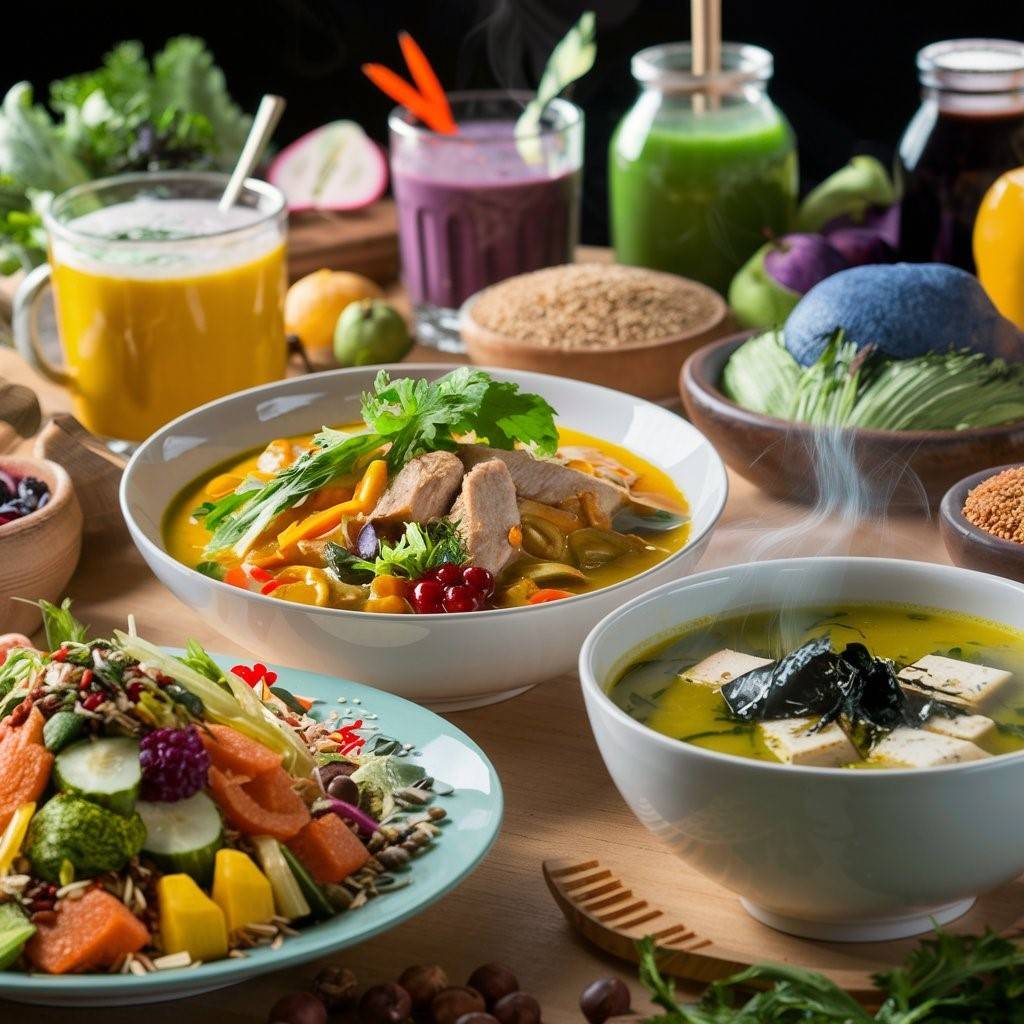Mind Diet: 10 Brain-Boosting Recipes to Supercharge Your Day!
Boost brain power with the Mind Diet! Get 10 delicious, nutritious recipes featuring leafy greens, berries, salmon & more to improve focus and prevent cognitive decline.
What is the Mind Diet?
The Mind Diet is a way of eating designed to prevent cognitive decline and reduce the risk of Alzheimer’s disease. Based on research from Rush University, this brain-healthy diet emphasizes foods rich in antioxidants, omega-3 fatty acids, and B vitamins – nutrients proven to boost brain power and protect against dementia.
Following the Mind Diet is simple: load up on plant-based foods like vegetables, fruits, whole grains, beans, nuts, and seeds while limiting red meat, butter, cheese, fried foods, and sweets. The diet encourages eating fatty fish like salmon at least once a week, too. But the Mind Diet is more than just a list of “good” and “bad” foods. It’s a simple approach to enjoy delicious, nutrient-dense meals that energize and nourish both body and mind.
10 Brain-Boosting Recipes to Eat on the Mind Diet
To get you started, here are 10 tasty Mind Diet recipes to help supercharge your brain power every day!
Smoked Salmon Avocado Toast
Smoked salmon is an excellent source of omega-3s, while avocado provides healthy monounsaturated fats to keep your brain fired up. Whole-grain toast adds a boost of fiber too.
Berry Green Smoothie
Load up on antioxidants from berries, spinach, and nut butter in this nutrient-packed smoothie. It’s the perfect Mind Diet breakfast or snack!
Quinoa Mind Diet Power Bowl
This colorful veggie-packed grain bowl has it all: fibre from quinoa, healthy fats from avocado, and antioxidants galore from beets, kale, and more. Top with your favorite Mind Diet protein, like salmon or chickpeas.
Walnut Cranberry Salad
Walnuts provide an excellent source of alpha-linolenic acid, an omega-3 fatty acid that’s key for cognitive health. Fresh cranberries add a burst of antioxidants and flavor.
Lentil Veggie Soup
Packed with brain-healthy lentils, spinach, carrots and more, this simple, savory soup makes the perfect light Mind Diet lunch or dinner option.
Baked Sweet Potato Fries
Sweet potatoes are loaded with antioxidants, vitamins, and minerals to feed your mind. Bake them into healthy fries and serve with a Greek yogurt dipping sauce.
Grilled Salmon with Quinoa
Can’t go wrong with this simple pairing of omega-3-rich grilled salmon and fiber-full quinoa. Add your favorite veggies on the side for a complete, brain-fueling meal.
Trail Mix
Keep your mind sharp with an easy homemade trail mix made from nuts, seeds, dried fruit, and dark chocolate chunks – all Mind Diet-approved!
Blueberry Overnight Oats
Make these overnight oats with antioxidant-rich blueberries, chia seeds, and your milk of choice for a convenient, fiber and protein-packed breakfast.
Veggie Stir Fry
Load up on an array of fresh or frozen veggies like broccoli, carrots, and bell peppers in this quick stir-fry. Pair with brown rice or quinoa to complete the Mind Diet-approved meal.
Brain Fuel: Key Mind Diet Food Groups

The Mind Diet recommends eating from 10 brain-healthy food groups as part of an overall balanced eating pattern:
Whole Grains
Oats, brown rice, quinoa, whole wheat bread, and pasta provide steady energy from complex carbs to power an active mind. Aim for 3+ servings per day.
Vegetables (especially leafy greens)
Veggies are packed with antioxidants, folate, lutein, and other nutrients shown to slow cognitive decline. Leafy greens like spinach and kale are superstars. Eat 6+ servings daily.
Nuts
Walnuts, almonds, pistachios, and other nuts contain healthy fats, antioxidants, and vitamin E to enhance brain function. Aim for 1/2 cup per day.
Berries
All berries are excellent brain foods thanks to their high antioxidant content. Blueberries and strawberries may be most beneficial. Eat 1-2 cups daily.
Beans and Lentils
Packed with fiber and nutrients like folate and magnesium, beans, and lentils help stabilize blood sugar and reduce inflammation. Eat 3-4 servings per week.
Olive Oil
Using olive oil as your main dietary fat boosts your intake of healthy monounsaturated fats and antioxidants like oleuropein. Use liberally while cooking and in dressings.
Poultry
A lean source of protein, eat poultry like chicken or turkey at least twice per week. Choose grilled or baked preparations.
Fish
Fatty fish like salmon and tuna are loaded with brain-boosting omega-3s. The Mind Diet calls for at least one seafood meal weekly.
Nuts and Seeds
Besides the other benefits noted above, nuts and seeds provide vitamin E to support cognitive health. Sprinkle on salads, and yogurt or eat as snacks.
Benefits of the Mind Diet for Brain Health
Studies show the Mind Diet can significantly reduce the risk of developing Alzheimer’s disease and slow cognitive decline associated with aging. Researchers believe the diet is so effective because it targets multiple brain-protecting mechanisms:
- Reduces inflammation.
- Improves cardiovascular health.
- Provides antioxidant protection.
- Enhances communication between brain cells.
- Stabilizes blood sugar and insulin levels.
- Supports the formation of new brain cells.
Even without fully adhering to the Mind Diet, eating more of the recommended brain-healthy foods can provide cognitive benefits. For example, studies tie higher intakes of vegetables, berries, olive oil, and omega-3s to better brain function and memory.
Beyond Alzheimer’s prevention, the Mind Diet‘s emphasis on nutrient-dense whole foods may also reduce the risk of other conditions like Parkinson’s, depression, and stroke. Following a plant-based, anti-inflammatory diet supports overall health, too.
To maximize the brain-boosting power of the Mind Diet, it’s best to combine it with other healthy lifestyle habits, like:
- Regular exercise
- Good sleep habits
- Stress management.
- Social engagement
- Cognitive training
The Mind Diet is not a quick-fix solution, but a sustainable, well-rounded approach for lifelong brain nourishment.
Mind diet recipes.

Here are 12 delicious and nutritious recipes to follow the Mind Diet and boost your brain health:
Smoked Salmon Avocado Toast
Ingredients:
- Whole grain bread, toasted.
- Ripe avocado, mashed.
- Smoked salmon
- Lemon juice
- Salt and pepper to taste
- Chopped dill for garnish.
Layer mashed avocado and smoked salmon over whole-grain toast. Squeeze fresh lemon juice over top and season with salt, pepper, and dill.
Berry Green Smoothie
Ingredients:
- 1 cup spinach or kale
- 1 cup mixed berries
- 1 banana
- 1 tbsp almond butter
- 1 cup unsweetened almond milk
- 1 tbsp chia seeds or ground flaxseeds
Blend all ingredients until smooth.
Quinoa Power Bowl
Ingredients:
- Cooked quinoa
- Roasted beets
- Steamed kale or spinach.
- Avocado slices
- Chickpeas or lentils
- Pumpkin seeds
- Balsamic vinaigrette
Layer quinoa, beets, greens, avocado, chickpeas, and pumpkin seeds in a bowl. Drizzle with balsamic dressing.
Walnut Cranberry Salad
Ingredients:
- Mixed greens
- Toasted walnuts
- Dried cranberries
- Crumbled feta or goat cheese
- Sliced pear
- Balsamic vinaigrette
Toss greens with walnuts, cranberries, cheese, and pear. Dress with balsamic vinaigrette.
Lentil Veggie Soup
Ingredients:
- Olive oil
- Diced onion, carrots, and celery.
- Minced garlic
- Vegetable or chicken broth
- Cooked lentils
Diced tomatoes.
- Chopped spinach.
- Lemon juice
- Salt and pepper
Sauté veggies in olive oil and add broth, lentils, and tomatoes. Simmer then stir in spinach and lemon juice before serving.
Baked Sweet Potato Fries
Ingredients:
- Sweet potatoes, cut into wedges.
- Olive oil
- Salt, pepper, paprika
Toss sweet potato wedges with olive oil and spices. Bake at 400°F until crispy, flipping halfway.
Grilled Mind Diet Salmon with Quinoa
Ingredients:
- Salmon fillets
- Olive oil, lemon, and dill for brushing
- Cooked quinoa
- Steamed veggies like asparagus or broccolini.
Brush salmon with olive oil, lemon, and dill. Grill until cooked through. Serve quinoa with steamed veggies.
Trail Mix
Ingredients:
- Unsalted nuts like walnuts, almonds, cashews
- Pumpkin or sunflower seeds
- Dried unsweetened cherries or cranberries
- Dark chocolate chunks or cacao nibs
Mix nuts, seeds, dried fruit and dark chocolate chunks.
Blueberry Overnight Oats
Ingredients:
- Rolled oats.
- Milk of choice
- Greek yogurt
- Blueberries
- Chia seeds
- Cinnamon and vanilla
- Chopped walnuts.
Mix oats, milk, yogurt, berries, chia, cinnamon, and vanilla. Top with walnuts and refrigerate overnight.
Veggie Stir Fry
Ingredients:
- Assortment of fresh veggies like broccoli, bell pepper, snap peas, carrots
- Olive oil
- Garlic
- Ginger
- Low-sodium soy sauce or teriyaki
- Cooked quinoa or brown rice
Saute garlic and ginger in olive oil, add veggies and stir-fry until crisp-tender. Toss with soy sauce and serve over quinoa or brown rice.
Mind Diet Mediterranean Chickpea Salad
Ingredients:
- Chickpeas
- Cherry tomatoes
- Diced cucumber.
- Red onion
- Kalamata olives
- Fresh parsley
- Crumbled feta
- Lemon juice
- Olive oil
Toss all ingredients together for a flavorful, filling chickpea salad.
Turmeric Salmon with Quinoa and Kale
Ingredients:
- Salmon fillets
- Turmeric, paprika, salt, pepper
- Cooked quinoa
- Sautéed kale
- Lemon wedges
Season salmon with spices and bake. Serve over quinoa and wilted kale. Squeeze lemon over top.
Making the Mind Diet a Lifestyle
Like any healthy diet, the Mind Diet is intended to be a lifestyle rather than a temporary fix. It requires a commitment to eat more nutrient-dense whole foods while limiting processed items. But it’s not as restrictive as a conventional “diet” – there’s room for the occasional indulgence in moderation.
The key is establishing new habits around meal planning, grocery shopping, and cooking. Start by slowly incorporating more Mind Diet foods like leafy greens, berries, and fish. Eat less fried foods, sweets, red meat, and full-fat dairy. Adopt simple cooking methods like roasting, grilling, sautéing, or steaming.
Involving friends or family in the Mind Diet journey can make it easier and more sustainable. Meal prepping, cooking together, and sharing recipes add support and enjoyment.
Be patient and make changes gradually to build long-term healthy habits. Over time, your taste preferences, and cravings will adapt to enjoy the flavors and nutrition of whole, minimally processed Mind Diet meals.
If following the Mind Diet 100% seems overwhelming, research shows cognitive benefits from simply eating more of the recommended brain foods as part of your current diet. Every positive nutrition change matters for mental sharpness over time.
Sample Mind Diet Meal Plan

Here’s an example of what a day of meals could look like on the Mind Diet:
Breakfast: Overnight oats made with skim milk, berries, chia seeds, and walnuts
Lunch: Big salad with leafy greens, tomatoes, avocado, chickpeas, and olive oil/vinegar dressing
Snack: Greek yogurt with mixed berries and slivered almonds
Dinner: Grilled salmon, quinoa, roasted brussels sprouts, and sweet potato
Dessert: Small square of dark chocolate and herbal tea
This balanced day provides a variety of Mind Diet brain nutrients like omega-3s, antioxidants, B vitamins, fiber, and more – all while limiting saturated fat, sodium, and simple sugars. With a little planning, delicious, and nutritious Mind Diet eating is achievable Daily.
What Foods to Avoid or Limit on the MIND Diet?
Here are the main foods to avoid or limit on the MIND diet:
- Red meat (beef, pork, lamb)
-
- Limit to no more than 1-2 servings per week
- Butter and margarine
-
- Use olive oil instead of butter for cooking and flavouring
- Cheese
-
- Choose low-fat cheeses and limit to 1-2 servings per week
- Pastries and sweets
-
- Limit cakes, cookies, donuts, ice cream, etc.
- Fried or fast foods
-
- Avoid fried meats, fries, chicken nuggets, etc.
- Processed meats
-
- Limit bacon, sausages, deli meats, hot dogs
- Whole-fat dairy products
-
- Choose low-fat or non-fat milk, yogurt, etc.
- Refined grains
-
- Avoid white bread, white rice, sugary cereals
- Sugary beverages
-
- Limit sodas, fruit juices, sweetened coffee drinks
- Excessive alcohol
-
- No more than one 5 oz glass of red wine per day
The MIND diet emphasizes nutrient-dense plant foods while limiting saturated and trans fats, sodium, added sugars, and highly processed items. Focus on eating plenty of vegetables, berries, whole grains, beans, nuts, seeds, olive oil, and fish.
DASH Diet vs Mind Diet
The DASH (Dietary Approaches to Stop Hypertension) Diet and Mind Diet have some similarities, but also key differences:
Differences
| DASH Diet | Mind Diet | |
| Main Purpose | Control blood pressure | Boost brain health, prevent dementia |
| Grains | Recommends 6-8 servings of whole grains daily | Requires at least 3 servings of whole grains |
| Fruits & Veggies | 4-5 servings each of fruits & veggies per day | 6+ servings of veggies, particularly leafy greens. Berries strongly emphasized. |
| Dairy | 2-3 servings of low-fat dairy per day | Low-fat dairy limited |
| Meat | Lean meats, poultry & fish | Poultry & fish preferred, red meat limited |
| Nuts/Seeds | 4-5 servings per week | 1 serving per day |
| Alcohol | Men: 2 drinks max, Women: 1 drink max | Optional 1 glass of red wine per day |
Conclusion
The Mind Diet is an exciting blueprint for supporting lifelong cognitive vitality through diet and lifestyle habits. By filling up on nutrient powerhouses like leafy greens, berries, whole grains, olive oil, and fish, you’ll give your brain the nourishment it needs to operate at its best.
With our 10 tasty Mind Diet recipes, you have a variety of easy, affordable options to start powering your day with brain-boosting foods. From energizing smoothies to satisfying grain bowls and more, these dishes make eating a breeze for better focus, memory, and mental clarity.
Remember, beyond the Mind Diet food choices, an overall healthy lifestyle is key for staving off age-related cognitive decline. Pair a Mind Diet eating pattern with regular physical activity, ample sleep, stress relief, and social connection for maximum brain-protective effects.
Committing to the Mind Diet is an investment in your present self and your future mental capacities. With its emphasis on wholesome, anti-inflammatory foods, you’ll feel the focus-enhancing difference while also reducing disease risks. What could be better fuel for supporting a sharp, vibrant mind well into your golden years?



